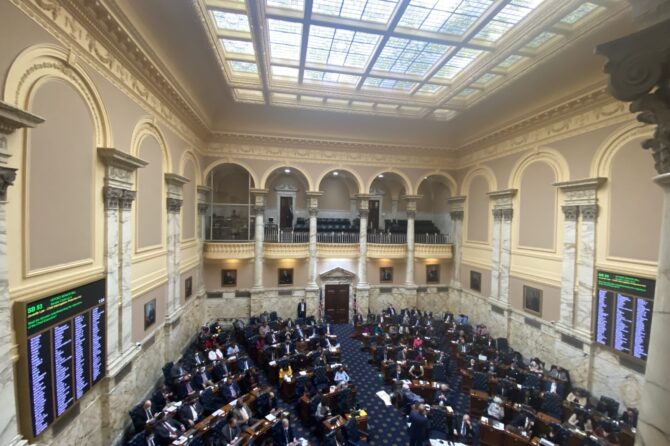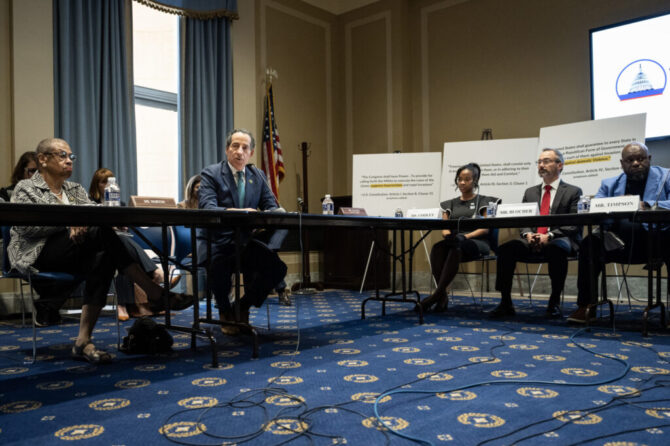MARYLAND MATTERS: The bipartisan tax package passed by the U.S. House last month is not a done deal, but the proposal’s supporters say it could restore some poverty-reducing benefits that reached millions under the pandemic-era child tax credit expansion.
A majority of low-income families who do not currently qualify for the full credit would see some increase just within the first year of the three-year deal, according to an analysis by the Center on Budget and Policy Priorities.
The center estimates within the initial year of the legislation, if enacted, 16 million of the 19 million children in low-income households that don’t receive the full credit because of low earnings would benefit.
States topping the list of where those children live include California, Texas, Florida, New York, Georgia, Illinois, Ohio, North Carolina, Pennsylvania and Michigan, in that order.
“This is really Congress’ only shot this year to pass legislation that would substantially boost the incomes of millions of low-income families and substantially lower child poverty,” said Stephanie Hingtgen, research analyst for the liberal-leaning Center on Budget and Policy Priorities.
A successful bipartisan, bicameral legislative package would be a rare win for both lawmakers and the Biden administration, particularly during an election year. Many of those parents who would see gains live in key 2024 swing states.
The CBPP’s analysis calculates that roughly 400,000 children would be lifted above the poverty line within the first year. The overall benefits would reach families across race and ethnicity, and would particularly help families in low-income rural areas, according to an additional report.
Hingtgen found that families of 2.5 million children in rural areas would see an increase in the first year. Georgia, Kentucky, Mississippi, North Carolina, Ohio, and Texas would each see more than 100,000 children benefit in their respective rural communities, she reported.
Both Democrats and Republicans tout the deal, dubbed the Tax Relief for American Families and Workers Act, as a compromise because it would expand the child tax credit while extending Trump-era corporate tax incentives through 2025.
Increasing child tax credit benefits has been a rallying cry for Democrats since the temporary pandemic-era expansion for 2021 lifted more than 2 million children out of poverty, according to census data.
Recent history of the child tax credit
The tax break amount per child was doubled under the Tax Cuts and Jobs Act of 2017, from up to $1,000 to up to $2,000 per child under age 17. The actual refundable portion of that credit for 2023 — meaning how much a parent could see in a refund check after his or her tax liability — is capped at $1,600.
However, low-income earners hardly ever hit the full refund amount because it phases in at 15% on the dollar for earned income above $2,500. Households that earn less do not even qualify.
As the current law stands, a single parent with two children would need to earn about $29,000 annually to receive the full credit, or about $34,000 for married parents, according to the Center on Budget and Policy Priorities. Families with more than two children would need an even higher annual income level to realize the full credit.
As the U.S. was digging out from under the COVID-19 economic fallout, Congress approved a one-year expansion of the tax credit to $3,000 per child under age 18, and $3,600 for those under age 6 — even for families who made $0 to $2,500 in income. Lawmakers made the entire amount refundable, and a portion of it was sent to families in monthly installments.
Advocates hailed the research findings that showed the temporary move was a game changer for poverty in the U.S.
Hope for low-income earners?
The changes under negotiation in Congress right now contain several advantages for low- earning parents: For one, the refundable portion of the credit would increase incrementally over the 2023, 2024 and 2025 tax years — from $1,800 to $1,900 to $2,000.
Secondly, parents could use their current or previous year’s income to calculate their tax credit — what tax experts call a “look-back” approach — and therefore maximize their refund checks. That way, if a parent or couple falls on hard times because of job loss or illness, they can choose to use a previous year’s higher income on their tax return when claiming the credit.
Third, the credit would phase in at 15% per dollar per child on earnings above $2,500, therefore allowing bigger families to reach the full credit faster (as illustrated in a helpful table from the Tax Policy Center).
“For example, a family that consists of a married couple with three children — one parent earns $32,000 as a farm worker, while the other parent stays at home to care for their two younger kids, while their older one is in school — I mean, under the expansion, the family would get about $1,900 per child for a total of $5,800. And that is an increase of almost $1,000 compared to current law,” Hingtgen said.
“So that’s real money that the family can use to help buy food, clothes or school materials for their children.”
Senate GOP opposition
While the legislation received overwhelming bipartisan support in the U.S. House on Jan. 31 when it passed in a 357-70 vote, the deal is hitting opposition from some Republican lawmakers in the U.S. Senate.
Several, including GOP Sen. Mike Crapo of Idaho, the ranking member on the Senate Committee on Finance, hope to make “necessary changes to build support,” as Crapo stated after the lower chamber’s vote.
Both Crapo and Republican Sen. John Thune of South Dakota told reporters that one of their top concerns is the “look-back” provision that would allow parents to use prior-year earnings, according to comments the senators made during hallway interviews compiled by Crapo’s office.
Researchers at the American Enterprise Institute published a paper in January warning that the option for parents to calculate their eligibility using their current earnings or the prior year’s income “would have important impacts on the labor market that require further study before being considered for passage by Congress.”
According to the AEI’s analysis, the every-other-year change would “lead over 700,000 parents to stop working.” At the same time, the change would double the work incentive for a minority of caregivers who don’t work in a two-year period and “lead 395,000 parents to start working,” write the researchers Kevin Corinth, Angela Rachidi, Matt Weidinger, and Scott Winship.
Hingtgen disputes that argument.
“The credit as a whole is only going to families that have earnings, and the look-back provision is only applying to people who have a history of earnings, so it is really not a concern,” she said.
Coupling the expansion with corporate tax breaks
Other criticism of the deal is aimed at the “horsetrading” that lawmakers are characterizing as compromise, according to the group Patriotic Millionaires.
Alongside the child tax credit expansion, the legislation revives corporate tax breaks that are winding down or expired under the 2017 tax law.
Among them is a provision that allows companies to expense purchases, for example a $30 million piece of equipment, in the first taxable year rather than getting a deduction over a multi-year period, as was previous law.
Patriotic Millionaires, a group of high-net-worth individuals who lobby Congress on tax policy, calls this “a lopsided trade.”
“Those tax cuts are going into the pockets of America’s very, very rich,” said Bob Lord, the group’s senior adviser on tax policy. “… There shouldn’t have to be ransom paid to America’s super rich every time we want to help poor children.”
A timeframe on when the tax deal could receive a vote in the Senate is unclear.
If opposing senators let the upper chamber’s legislative clock run out on the deal this year, the lawmakers will not be able to escape looming tax policy negotiations as the Trump-era tax law further winds down in 2025.
Democratic Sen. Ron Wyden of Oregon, chair of the Senate Finance Committee, is in regular talks with colleagues and Majority Leader Chuck Schumer of New York, according to committee staff.
“No decisions have been made at this point with respect to a markup or floor process, but obviously Senator Wyden’s goal is to move as quickly as possible to get the expanded CTC out to kids and families who qualify,” said Ryan Carey, committee spokesperson.










